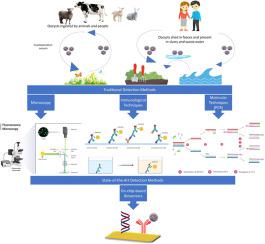Journal of Hazardous Materials ( IF 12.2 ) Pub Date : 2021-07-21 , DOI: 10.1016/j.jhazmat.2021.126714 George Luka 1 , Ehsan Samiei 2 , Nishat Tasnim 1 , Arash Dalili 1 , Homayoun Najjaran 1 , Mina Hoorfar 1

|
Cryptosporidium is a critical waterborne protozoan pathogen found in water resources that have been a major cause of death and serious illnesses worldwide, costing millions of dollars annually for its detection and treatment. Over the past several decades, substantial efforts have been made towards developing techniques for the detection of Cryptosporidium. Early diagnostic techniques were established based on the existing tools in laboratories, such as microscopes. Advancements in fluorescence microscopy, immunological, and molecular techniques have led to the development of several kits for the detection of Cryptosporidium spp. However, these methods have several limitations, such as long processing times, large sample volumes, the requirement for bulky and expensive laboratory tools, and the high cost of reagents. There is an urgent need to improve these existing techniques and develop low-cost, portable and rapid detection tools for applications in the water quality industry. In this review, we compare recent advances in nanotechnology, biosensing and microfluidics that have facilitated the development of sophisticated tools for the detection of Cryptosporidium spp.Finally, we highlight the advantages and disadvantages, of these state-of-the-art detection methods compared to current analytical methodologies and discuss the need for future developments to improve such methods for detecting Cryptosporidium in the water supply chain to enable real-time and on-site monitoring in water resources and remote areas.
中文翻译:

对隐孢子虫常规和最先进检测方法的全面回顾
隐孢子虫是在水资源中发现的一种重要的水传播原生动物病原体,已成为全世界死亡和严重疾病的主要原因,每年花费数百万美元用于检测和治疗。在过去的几十年中,已经为开发检测隐孢子虫的技术做出了巨大的努力。早期诊断技术是基于实验室中现有的工具(例如显微镜)建立的。荧光显微镜、免疫学和分子技术的进步导致开发了几种用于检测隐孢子虫的试剂盒spp. 然而,这些方法有一些局限性,例如处理时间长、样本量大、需要笨重且昂贵的实验室工具以及试剂成本高。迫切需要改进这些现有技术并开发用于水质行业应用的低成本、便携和快速检测工具。在这篇综述中,我们比较了纳米技术、生物传感和微流体方面的最新进展,这些进展促进了用于检测隐孢子虫的复杂工具的开发。最后,我们强调了这些最先进的检测方法比较的优缺点对当前的分析方法进行讨论,并讨论未来发展以改进此类检测隐孢子虫的方法的必要性在供水链中实现对水资源和偏远地区的实时和现场监测。











































 京公网安备 11010802027423号
京公网安备 11010802027423号